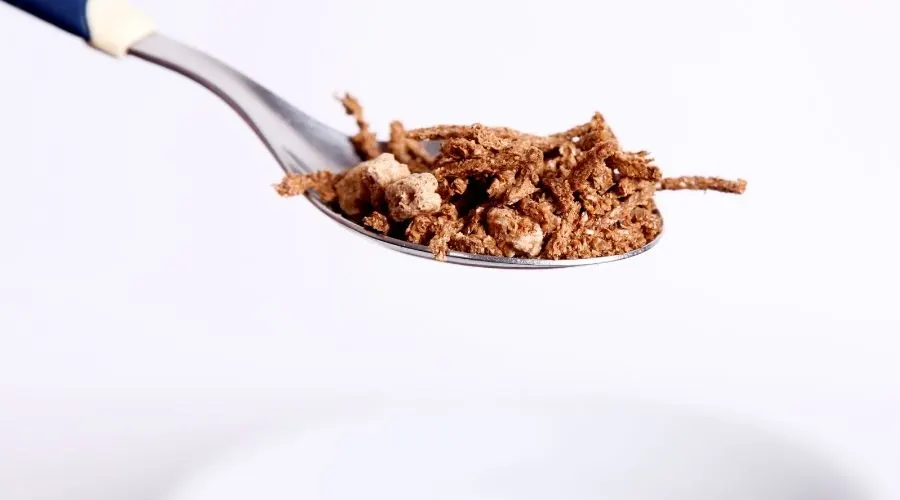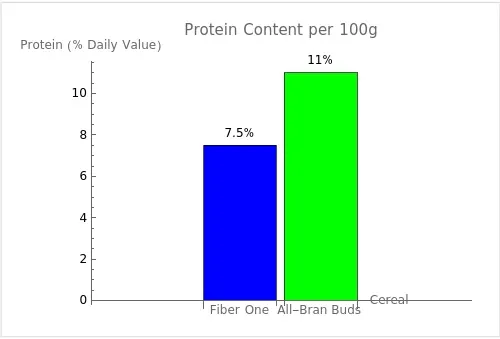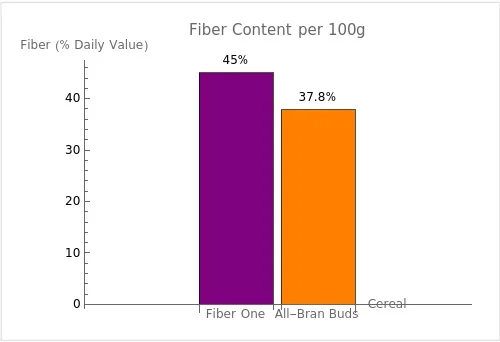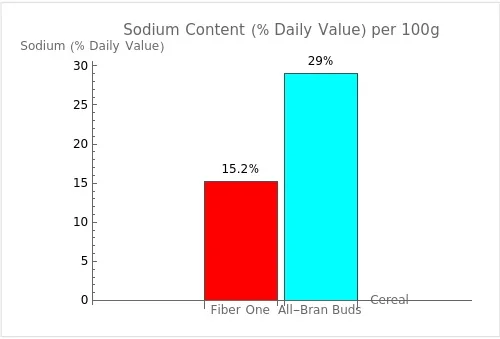Do you ever find yourself standing in the cereal aisle at the grocery store, wondering which cereal is actually going to be healthy for you and your family?
If so, you’re not alone. With so many options out there, it can be hard to know which one to choose. But fear not – we’re here to help.
Today, we’re comparing two popular high-fiber breakfast cereals – Fiber One and All-Bran Buds – to see which one comes out on top. Spoiler alert: it’s a close race, so keep reading to find out more!
Also in This Article
In a hurry, or looking for something specific? Use the links below to jump to the relevant section:
- Ingredients Comparison
- Fiber One Vs. All-Bran Nutritional Comparison:
- Best for Calorie Content
- Best for Carbs & Sugar Content
- Best for Protein Content
- Best for Fat Content
- Best for Fiber Content
- Best for Sodium/Salt Content
- Best for Vitamins/Minerals
- Best for Flavor/Texture
- Best for Price
- Overall Winner
Ingredients Comparision
Comparing ingredients between two products is an excellent way to see the key differences between the two.
When comparing General Mills’ Fiber One Cereal against Kellogg’s All-Bran Buds, the main difference is that Fiber one is predominately made from whole grain wheat and corn bran, whereas the main ingredient of All-Bran is Wheat Bran.
Both kinds of cereal are designed to be high-fiber breakfast options, and both are fortified with added vitamins and minerals in a bid to boost the daily intake of the consumer at breakfast time.
| Cereal Type | Ingredients | Added Vitamins and Minerals |
| Fiber One Cereal | Whole Grain Wheat, Corn Bran, Modified Wheat Starch, Color (caramel color and annatto extract), Guar Gum, Cellulose Gum, Salt, Baking Soda, Sucralose, Natural Flavor. | Calcium Carbonate, Vitamin C (sodium ascorbate), Iron and Zinc (mineral nutrients), A B Vitamin (niacinamide), Vitamin B6 (pyridoxine hydrochloride), Vitamin B1 (thiamin mononitrate), Vitamin B2 (riboflavin), A B Vitamin (folic acid), Vitamin B12. |
| All-Bran Buds | Wheat bran, sugar, psyllium seed husk, contains 2% or less of salt, baking soda, annatto color, bht for freshness. | Niacinamide, reduced iron, vitamin B6 (pyridoxine hydrochloride), vitamin B2 (riboflavin), vitamin B1 (thiamin hydrochloride), folic acid, vitamin D3, vitamin B12. |

Fiber One Vs. All-Bran Nutritional Comparison
Starting with the nutritional comparison of each cereal and for clarification, I’ll be comparing General Mills Original Fiber One Cereal weight-for-weight (per 100g) against Kellogg’s All-Bran Buds.
Each cereal has a different recommended serving size, so comparing servings won’t give a fair or accurate comparison; however, I’ve also included them for information.
Best for Calorie Content
Starting with calories and both kinds of cereals are a low-calorie option per serving, but Fiber One wins the category because it contains 19 calories less than All-Bran per 100g.
| Cereal Type | Calories Per 100g | Calories Per Serving |
| Fiber One Cereal | 225kcal | 90kcal (Per 40g Serving) |
| All-Bran Buds | 244kcal | 110kcal (Per 45g Serving) |
Best for Carbohydrate Content
When it comes to carbohydrates, neither cereal will win an award for being low-carb, but if this is a consideration for your diet, All-Bran Buds are the lower carb option of the two.
| Cereal Type | Carbohydrates Per 100g | Carbohydrates Per Serving |
| Fiber One Cereal | 85g | 34g (Per 40g Serving) |
| All-Bran Buds | 80g | 36g (Per 45g Serving) |
Best for Sugar Content
The results of the sugar category are pretty surprising because although you might think the sugar content of Fiber One and All-Bran would be pretty similar, there’s actually a vast difference between the two.
Fiber One is the clear winner of the best in sugar category, with no added sugar or sugar per serving, compared to All-Bran Buds, which contain 12g (over two teaspoonsful) per serving which is 24% of the recommended daily value.
| Cereal Type | Sugars Per 100g | Sugars Per Serving |
| Fiber One Cereal | 0g | 0g (Per 40g Serving) |
| All-Bran Buds | 26.7g | 12g (Per 45g Serving) |
Best for Protein Content
If protein content is an important consideration for you when choosing a breakfast cereal, All-Bran Buds are the best option with 2g more protein per serving than Fiber One Cereal.
| Cereal Type | Protein Per 100g | Protein Per Serving |
| Fiber One Cereal | 7.5g | 3g (Per 40g Serving) |
| All-Bran Buds | 11g | 5g (Per 45g Serving) |
Based on a 2,000 calorie diet, the recommended daily intake of protein is about 50 grams. This means that Fiber One Cereal provides 15% of the daily value, while All-Bran Buds provides 22% of the daily value for protein per 100g.

Best for Fat Content
When it comes to fat content, both Fiber One and All-Bran Buds are low-fat breakfast options, and there is little difference between the two; however, All-Bran Buds are slightly higher in fat than Fiber One.
| Cereal Type | Fat Per 100g | Saturated Fat per 100g |
| Fiber One Cereal | 2.5g | 0g |
| All-Bran Buds | 3.3g | 0g |
Cholesterol
If you’re looking for a breakfast option that doesn’t contain cholesterol, then either Fiber One or All-Bran Buds are an excellent choice for you as neither has any cholesterol per serving.
Best for Fiber Content
Most people choose Fiber One or All-Bran because they’re known for their high-fiber content, but which is the best between the two?
I can confirm that the winner of the fiber category is Fiber One, with a huge 18g of dietary fiber per serving. To put this value into context, Fiber one contains 65% of your recommended fiber intake in one serving.
All-Bran is also an excellent option for a high fiber cereal, and per serving, it contains 61% of the recommended daily value, which is an impressive amount of fiber to kick-start your day.
| Cereal Type | Dietary Fiber Per 100g | Dietary Fiber per Serving |
| Fiber One Cereal | 45g | 18g (Per 40g Serving) |
| All-Bran Buds | 37.8g | 17g (Per 45g Serving) |
Based on a 2,000 calorie diet, the recommended daily intake of fiber is about 25 grams. This means that Fiber One provides 180% of the daily value, while All-Bran Buds provides 151.2% of the daily value for fiber per 100g.

Best for Sodium/Salt Content
The best cereal for sodium content between Fiber One and All-Bran Buds is Fiber one, with just under half of the amount of sodium than All-Bran per weight.
To put this into the perspective of a daily recommended value percentage, Fiber One contains 6% of the recommended sodium intake compared to All-Bran, which contains 13% per serving.
| Cereal Type | Sodium/Salt Per 100g | Sodium/Salt per Serving |
| Fiber One Cereal | 350mg | 140mg (Per 40g Serving) |
| All-Bran Buds | 666.7mg | 300mg (Per 45g Serving) |
Based on a 2,000 calorie diet, the recommended daily intake of sodium is about 2,300 mg. This means that Fiber One contains 15.2% of the daily value, while All-Bran Buds contains 29% of the daily value for sodium per 100g.

Best for Vitamins/Minerals
When comparing vitamins and minerals for each cereal, some nutrients aren’t found in All-Bran; however, All-Bran is higher in more nutrients than Fiber one, which levels out the two.
Because there’s no clear winner, I’ve classed them as joint winners because both have a good amount of vitamins and minerals that help to contribute towards recommended daily intakes.
The table below shows the daily value percentage for each cereal based on information from the manufacturer.
| Vitamin/Mineral Type | Fiber One Daily Values | All-Bran Buds Daily Values |
| Vitamin D | 0% | 10% |
| Calcium | 10% | 2% |
| Iron | 20% | 25% |
| Potassium | 0% | 8% |
| Magnesium | 8% | – |
| Thiamin | 20% | 20% |
| Riboflavin | 10% | 20% |
| Vitamin B6 | 20% | 20% |
| Vitamin C | 10% | – |
| Vitamin B12 | 20% | 20% |
| Folic Acid | 20% | 20% |
| Phosphorus | 6% | – |
Best for Flavor/Texture
When judging the best for flavor and texture, this is subjective and down to the individual, so to properly understand which is the public favorite when it comes to taste, we need to do a poll.
Please help our future readers and us by voting for your favorite in the poll below, and once you vote, the percentages so far will be revealed.
Best for Price
At the time of writing this article, a 22oz box of All-Bran Buds costs an average of $3.98, which is equal to $0.18 per ounce, whereas a 19.6oz box of Fiber one costs an average of $4.18, which is equal to $0.21 per ounce.
Based on this information, All-Bran Buds are slightly cheaper than Fiber One per ounce, although please note, this may vary depending on pack-sizes, offers, and where you shop.
Overall Winner
The votes are all in, and I can now reveal a winner of the best cereal between Fiber One Original Cereal and All-Bran Buds – and the winner is – Fiber One!
| Comparison Category | Winner (Fiber One or All-Bran Buds) |
| Best for Calorie Content | Fiber One |
| Best for Carbohydrate Content | All-Bran Buds |
| Best for Sugar Content | Fiber One |
| Best for Protein Content | All-Bran Buds |
| Best for Fat Content | Fiber One |
| Best for Fiber Content | Fiber One |
| Best for Sodium Content | Fiber One |
| Best for Vitamins/Minerals | Joint Winners |
| Best for Price | All-Bran Buds |
| Overall Winner | Fiber One |
Related Articles
I hope this article has helped you to find the information you were looking for; you might also find the following articles helpful too:
Special K Vs. Bran Flakes (Which is Best?)
Froot Loops Vs. Fruity Pebbles (Which is Best?)
Fresh Pineapple Vs. Canned (Which is Best?)
References Used for this Article
To ensure the nutritional information used in this article is accurate, I have used data from the manufacturer; the links below contain the source information:
